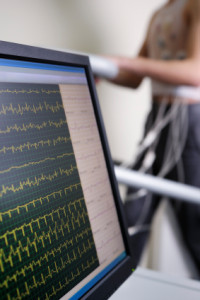A FEW FACTS
 Stress testing is a painless, safe method to measure how well the heart responds to an increase in the body’s demand for oxygen.
Stress testing is a painless, safe method to measure how well the heart responds to an increase in the body’s demand for oxygen.- Exercise is the most commonly used method of creating this increased stress on the heart.
- The electrocardiographic (ECG) stress test is the second most-performed heart diagnostic test next to the resting, or standard, ECG.
- The person taking the test may choose to stop the ECG stress test at any time.
An electrocardiogram (ECG) stress test monitors a person’s heartbeat at rest and during exercise, most commonly while a person walks on a treadmill. A physician observes the person, monitors the exercise level, and makes recordings until the person’s heart nears a maximum predicted heart rate. The heart also is monitored during the period of cool-down or recovery that immediately follows exercise. The recordings made before, during, and immediately after an ECG stress test can show subtle changes in heart electrical activity that can help a physician:
- Determine physical fitness;
- Locate areas of the heart that receive an insufficient blood and oxygen supply;
- Reveal heart rhythm abnormalities;
- Evaluate a person’s prognosis after a heart attack;
- Verify the effectiveness of medical and surgical therapies; and
- Determine an appropriate exercise program for people with known heart disease.
RISK FACTORS
ECG stress testing is painless, has little risk, and does not use radiation.
WHAT TO EXPECT
In the testing room, approximately 10 electrodes are attached to the person’s chest and back. The electrodes record the heart’s electrical impulses and transmit them to an electrocardiograph, a machine that turns the impulses into waves on graph paper or on a monitor screen. Time is recorded horizontally, and the duration and intensity of the heart’s electrical impulses is recorded vertically. People will also wear a blood pressure monitoring cuff or monitoring device during the test.
The electrodes may be placed on top of a light layer of gel that conducts electricity and helps ensure clear readings. Men should expect to have some chest hair shaved so that the electrodes will press directly against the skin.
As exercise begins, the patient walks slowly on the treadmill. The speed and incline of the treadmill increase slowly, typically about every 3 minutes. The test ends once the person cannot continue because of fatigue, shortness of breath, or chest pain. The physician evaluates the test results and discusses them with the patient after the test.
One disadvantage to ECG stress testing is that recordings can appear normal despite the presence of some heart dysfunction, which is called a false-negative result, or show an abnormality when there isn’t one, called a false-positive result. Stress ECGs produce a high rate of false-positive results in women. In some cases, additional testing may be required.
POST-TEST GUIDELINES
Most patients resume usual activities immediately following ECG stress testing.
PRE-TEST GUIDELINES
It is recommended that people wear clothing that is comfortable to exercise in and avoid strenuous exercise and eating or drinking, and using tobacco products for approximately two hours before the test.
